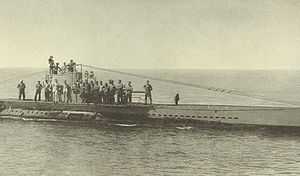SM U-38
 SM U-38 with crew | |
| Career (German Empire) | |
|---|---|
| Name: | U-38 |
| Ordered: | 12 June 1912 |
| Builder: | Germaniawerft, Kiel |
| Laid down: | 25 February 1913 |
| Launched: | 9 September 1914 |
| Commissioned: | 15 December 1914 |
| Fate: | Surrendered 23 February 1919. |
| General characteristics | |
| Class & type: | German Type U 31 submarine |
| Displacement: |
685 tons surfaced 878 tons submerged 971 tons (total) |
| Length: |
64.70 m (overall) 52.36 m (pressure hull) |
| Beam: |
6.32 m (overall) 4.05 m (pressure hull) |
| Height: | 7.68 m |
| Draught: | 3.56 m |
| Propulsion: |
Diesel (2 x 950 PS) Electric (2 x 600 PS) 1850 hp surfaced 1200 hp submerged |
| Speed: |
16.4 knots surfaced 9.7 knots submerged |
| Range: | 8790 miles at 8 kn surfaced 80 miles at 5 knsubmerged[1] |
| Test depth: | 50 m |
| Complement: |
4 officers 31 crewmen |
| Armament: | |
| Service record | |
|---|---|
| Part of: | II Flottille, Imperial German Navy |
| Commanders: |
Max Valentiner Wilhelm Canaris Hans Heinrich Wurmbach Clemens Wickel |
| Operations: | 17 |
| Victories: |
138 ships sunk for a total of 292,848 tons. 5 ships damaged for a total of 27,112 tons. 1 ship taken as prize for a total of 1,441 tons. 1 warship damaged for a total of 10,850 tons. |
SM U-38 was a German Type U 31 U-boat which operated in the Mediterranean Sea during World War I. It ended up being the third most successful u-boat participating in the war sinking 138 ships sunk for a total of 299.985 tons.
Its longest serving captain was Max Valentiner, who was awarded the Pour le Mérite while in command of U-38. Valentiner was in command of U-38 in November and December 1915 when she sank the passenger liners SS Ancona and SS Persia; both were controversial since the ships were sunk by torpedoes without warning, in defiance of the then-current Prize rules, which stated that merchant vessels carrying passengers be given an opportunity to evacuate their passengers before being sunk.
Valentiner was succeeded as commander of U-38 by Wilhelm Canaris, who later went on to become an Admiral and head of the Abwehr from 1935 to 1944.
Fate
After World War I ended, U-38 was surrendered to France and docked in Brest in 1919, and then broken up.
See also
- List of U-boats
- Room 40
Notes
References
- Eberhard Rössler: Geschichte des deutschen U-Bootbaus - Band 1. Bernhard & Graefe Verlag 1996, ISBN 3-86047-153-8
- Bodo Herzog: Deutsche U-Boote 1906-1966. Manfred Pawlak Verlags GmbH, Herrschingen 1990, ISBN 3-88199-687-7
- Spindler, Arno (1932,1933,1934,1941/1964,1966). Der Handelskrieg mit U-Booten. 5 Vols. Berlin: Mittler & Sohn. Vols. 4+5, dealing with 1917+18, are very hard to find: Guildhall Library, London, has them all, also Vol. 1-3 in an English translation: The submarine war against commerce.
- Beesly, Patrick (1982). Room 40: British Naval Intelligence 1914-1918. London: H Hamilton. ISBN 978-0-241-10864-2.
- Halpern, Paul G. (1938). A Naval History of World War I. New York: Routledge. ISBN 978-1-85728-498-0.
- Roessler, Eberhard (1997). Die Unterseeboote der Kaiserlichen Marine. Bonn: Bernard & Graefe. ISBN 978-3-7637-5963-7.
- Schroeder, Joachim (2002). Die U-Boote des Kaisers. Bonn: Bernard & Graefe. ISBN 978-3-7637-6235-4.
- Koerver, Hans Joachim (2008). Room 40: German Naval Warfare 1914-1918. Vol I., The Fleet in Action. Steinbach: LIS Reinisch. ISBN 978-3-902433-76-3.
- Koerver, Hans Joachim (2009). Room 40: German Naval Warfare 1914-1918. Vol II., The Fleet in Being. Steinbach: LIS Reinisch. ISBN 978-3-902433-77-0.
External links
- Homepage for Christian August Max Ahlmann Valentiner:
- Photos of cruises of German submarine U-54 in 1916-1918. Great photo quality, comments in German.
- A 44 min. film from 1917 about a cruise of the German submarine U-35. A German propaganda film without dead or wounded; many details about submarine warfare in World War I.
- Uboat.net: More detailed information about U-38.
- Room 40: original documents, photos and maps about World War I German submarine warfare and British Room 40 Intelligence from The National Archives, Kew, Richmond, UK.
| ||||||||